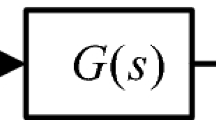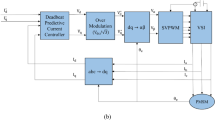Abstract
Among several aspects of stability of synchronous machine operation, an important aspect is the mode of ‘small perturbation stability’ referred to as steady-state, dynamic or conditional stability. Attention has been increasing on the effect of excitation control in damping small-frequency rotor oscillations which characterize the phenomena of dynamic stability. In particular, it has been found useful and practical to incorporate stabilizing signals derived from speed and/or terminal frequency and/or power superposed on the normal voltage error signal of automatic voltage regulators to provide an additional damping to these oscillations. Conventionally, the lead–lag power system stabilizer (CPSS) is employed to supplement stabilizing signal to normal voltage error signal for damping these rotor oscillations of small frequency typically ranges from 0.2 to 3.5 Hz. In recent years, researchers have been proposing linear quadratic regulator (LQR) to replace CPSS for damping these small-frequency rotor oscillations. In this paper, an ‘algebraic approach’ derived from the relationship between algebraic Riccati equation and Lagrange multiplier optimization technique is proposed to tune LQR. The performance of single-machine infinite-bus power system equipped with LQR tuned via the proposed analytical method has been tested in MATLAB/Simulink® environment.











Similar content being viewed by others
Abbreviations
- E b :
-
Infinite-bus voltage
- V s :
-
Secondary voltage of step-up transformer
- V t :
-
Generator terminal voltage
- \(E_{q}^{\prime}\) :
-
Equivalent induced voltage along q-axis
- P s :
-
Active power at step-up transformer secondary bus
- Q s :
-
Reactive power at step-up transformer secondary bus
- P t :
-
Active power at generator terminal
- Q t :
-
Reactive power at generator terminal
- P g :
-
Generated active power
- Q g :
-
Generated reactive power
- θ s :
-
Angle between Vs and Eb
- θ t :
-
Angle of terminal voltage Vt
- δ :
-
Rotor angle between Eb and q-axis
- δ s :
-
Rotor angle between Vs and q-axis
- R L :
-
Equivalent resistance of transmission system
- X L :
-
Equivalent reactance of transmission system
- R t :
-
Resistance of step-up transformer
- X t :
-
Reactance of step-up transformer
- R e :
-
Equivalent resistance of SMIB system
- X e :
-
Equivalent reactance of SMIB system
- \(x_{d}^{\prime}\) :
-
d-Axis transient reactance of generator
- H :
-
Inertia constant
- D :
-
Damping torque coefficient
- \(\omega_{B}\) :
-
Base angular frequency
- T m :
-
Mechanical torque input
- T e :
-
Electrical torque output
- T D :
-
Damping torque
- K E :
-
Exciter gain
- T E :
-
Exciter time constant
- \(T_{do}^{\prime}\) :
-
Open-circuit transient time constant
- T 1 :
-
Feed-forward time constant of phase compensator of CPSS
- T 2 :
-
Feed-backward time constant of phase compensator of CPSS
- T w :
-
Time constant of washout block of CPSS
References
F.P. Demello, C. Concordia, Concepts of synchronous machine stability as affected by excitation control. IEEE Trans. Power Appar. Syst. 88(4), 316–329 (1969)
E.V. Larsen, D.A. Swann, Applying power system stabilizers, part I: general concepts. IEEE Trans. Power Appar. Syst. 100(6), 3017–3024 (1981)
E.V. Larsen, D.A. Swann, Applying power system stabilizers, part II: performance objectives and tuning concepts. IEEE Trans. Power Appar. Syst. 100(6), 3025–3033 (1981)
E.V. Larsen, D.A. Swann, Applying power system stabilizers, part III: practical considerations. IEEE Trans. Power Appar. Syst. 100(6), 3034–3046 (1981)
A. Venkateswara Reddy, M. Vijaya Kumar, G. Gurunath, Novel approach for the design of state feedback power system stabilizers, in IEEE International Conference on Power System Technology (2010)
L. Yathisha, S. Patilkulkarni, LQR and LQG based optimal switching techniques for PSS and UPFC in power systems. Control Theory Technol. 16(1), 25–37 (2018)
A.E. Bryson Jr., H.Y. Chi, Applied Optimal Control: Optimization, Estimation, and Control (Hemisphere Publishing Corporation, Wiley, New York, 1975)
I. Robandi, K. Nishimori, R. Nishimura, N. Ishihara, Optimal feedback control design using genetic algorithm in multimachine power system. Int. J. Electr. Power Energy Syst. 23(4), 263–271 (2001)
M.I. Solihin, R. Akmeliawati, Particle swam optimization for stabilizing controller of a self-erecting linear inverted pendulum. Int. J. Electr. Electron. Syst. Res. 3, 13–23 (2010)
M. Almobaied, I. Eksin, M. Guzelkaya, Design of LQR controller with big bang-big crunch optimization algorithm based on time domain criteria, in IEEE—24th Mediterranean Conference on Control and Automation (MED), Athens, Greece (2016), pp. 1192–1197
A. Jacknoon, M.A. Abido, Ant colony based LQR and PID tuned parameters for controlling inverted pendulum, in IEEE–International Conference on Communication, Control, Computing and Electronics Engineering (ICCCCEE), Khartoum, Sudan (2017)
S. Das, I. Pan, K. Halder, S. Das, A. Gupta, LQR based improved discrete PID controller design via optimum selection of weighting matrices using fractional order integral performance index. Appl. Math. Model. 37, 4253–4268 (2013)
M. Jokarzadeh, M. Abedini, A. Seifi, Improving power system damping using a combination of optimal control theory and differential evolution algorithm. ISA Trans. 90, 169–177 (2018)
E. Okyere, A. Bousbaine, G.T. Poyi, A.K. Joseph, J.M. Andrade, LQR controller design for quad-rotor helicopters. J. Eng. 2019(17), 4003–4007 (2019)
G. Gurunath, S. Indraneel, A modified Heffron–Phillips model for the design of power system stabilizers, in Joint International Conference on Power System Technology and IEEE Power India Conference (2008)
G. Gurunath, S. Indraneel, Power system stabilizers design for interconnected power systems. IEEE Trans. Power Syst. 25(2), 1042–1051 (2010)
K.R. Padiyar, Power System Dynamics: Stability and Control (BS Publications, 2e, 2008)
K. Ogata, Modern Control Engineering (Pearson India Education Services Pvt. Ltd., 5e, 2016)
B.D.O. Anderson, J.B. Moore, Optimal Control: Linear Quadratic Methods (Prentice-Hall Inc., Englewood Cliffs, 1989)
Author information
Authors and Affiliations
Corresponding author
Additional information
Publisher's Note
Springer Nature remains neutral with regard to jurisdictional claims in published maps and institutional affiliations.
Rights and permissions
About this article
Cite this article
Uravakonda, S., Mallapu, V.K. & Annapu Reddy, V.R. Damping Enhancement for SMIB Power System Equipped with LQR Tuned via Analytical Approach. J. Inst. Eng. India Ser. B 101, 541–551 (2020). https://doi.org/10.1007/s40031-020-00484-3
Received:
Accepted:
Published:
Issue Date:
DOI: https://doi.org/10.1007/s40031-020-00484-3




